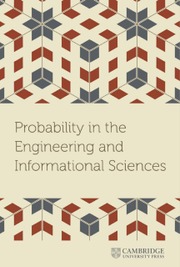No CrossRef data available.
Article contents
ESTIMATING THE RATE OF DEFECTS UNDER IMPERFECT SAMPLING INSPECTION—A NEW APPROACH
Published online by Cambridge University Press: 28 October 2019
Abstract
We consider the problem of estimating the rate of defects (mean number of defects per item), given the counts of defects detected by two independent imperfect inspectors on one sample of items. In contrast with the setting for the well-known method of Capture–Recapture, we do not have information regarding the number of defects jointly detected by both inspectors. We solve this problem by constructing two types of estimators—a simple moment-type estimator, and a complicated maximum-likelihood (ML) estimator. The performance of these estimators is studied analytically and by means of simulations. It is shown that the ML estimator is superior to the moment-type estimator. A systematic comparison with the Capture–Recapture method is also made.
MSC classification
Information
- Type
- Research Article
- Information
- Probability in the Engineering and Informational Sciences , Volume 35 , Issue 2 , April 2021 , pp. 242 - 257
- Copyright
- Copyright © Cambridge University Press 2019

